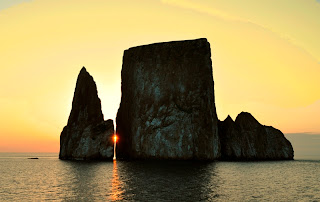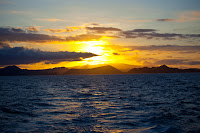 |
| Kicker Rock at Sunset |
While the sites on the island itself are all treasures, the beauty and magic of what lies a short boat ride from the harbor is truly dazzling. The first of these sites, and truly an iconic place in all of the Galapagos Islands, is Kicker Rock, sometimes called Leon Dormido. This is such a spectacular location, breathtaking at any time of day, that it warrants an entire post of its own, Kicker Rock.
PUERTO GRANDE
 |
| Photo of Puerto Grande from Galapagos National Park Service |
 |
| The Beach at Puerto Grande |
 |
| Flowers at Pueto Grande |
 |
| Sally Lightfoot Crab at Isla Lobos |
 |
| Galapagos National Park Service Photograph of Sea Lion at Isla Lobos |
PUNTA PITT
.JPG) |
| Looking down at Punta Pitt |
 |
| Everyone Enjoys Punta Pitt |
The trail at Pitt Point, which comprises a walk of about two hours, ascends to the top of a volcanic tuff and has several stunning vistas for photograph opportunities. The beach itself is populated by sea lions. Visitors hope to see all three species of boobies – Red-Footed, Blue-Footed and Nazca – when they visit Punta Pitt. According to the Galapagos National Park Service, it is the only place in the entire archipelago where all three species reside because of the abundance of small fish eaten by all three species of boobies. They all are excellent divers and can be seen in groups swooping down into dense schools of fish to eat their fill. Their nesting sites are segregated: Blue-Footed Boobies nest in the interior, Red-Footed Boobies nest on shrubs and Nazca boobies nest in the cliffs.
 Pitt Point is also the nesting site of frigate bird species. The stunning beach is crystalline in consistency and frequented by sea lions, frigates, pelicans, herons and gulls.
Pitt Point is also the nesting site of frigate bird species. The stunning beach is crystalline in consistency and frequented by sea lions, frigates, pelicans, herons and gulls.
WITCH HILL
 |
| Looking Through Witch Hill with Kicker Rock in the Background |
You don’t have to land on Witch Hill to appreciate its uniqueness. There is no place like it in all of the Galapagos. The cliffs are stunning; lie back in your panga and look up to get its full majestic quality. Your panga can drive through scenic p assages and you can see Kicker Rock on the other side. This is a stunning view. At Witch Hill is the chance again to swim and snorkel with sea lions and observe pelicans, Blue-Footed Boobies, iguanas and other Galapagos endemic marine life.
CARAGUA WRECK
 |
| Caragua Wreck Photos are taken by permission from Papertygre at http://www.flickr.com/photos/ratha/6458182965/ in/set-72157628286114989/ |
 Throughout WWI transport ships sailed around the Galapagos islands. It was right outside the harbor of Puerto Baquerizo Moreno that the WWI German transport ship Caragua sank 100 years ago. At the wreck site a reef-like environment has been created. SCUBA divers will be exposed to stingrays, nudibranches, corals, schools of fish, rays and sea lions. This remains one of the few wreck dives in Galapagos. The wreck is approximately 300 feet long and you can inspect the ship's remains including the propellers and boilers.
Throughout WWI transport ships sailed around the Galapagos islands. It was right outside the harbor of Puerto Baquerizo Moreno that the WWI German transport ship Caragua sank 100 years ago. At the wreck site a reef-like environment has been created. SCUBA divers will be exposed to stingrays, nudibranches, corals, schools of fish, rays and sea lions. This remains one of the few wreck dives in Galapagos. The wreck is approximately 300 feet long and you can inspect the ship's remains including the propellers and boilers.
OTHER VISITOR SITES
A few other sites near San Cristobal are the following:
Another popular boat trip from San Cristobal is Ochoa Beach, just 30 minutes away. This quiet beach is the home to many sea lions as well as ghost and hermit crabs. The birdlife here is prolific because of the pools that form along the shoreline. Endemic mockingbirds also frequent this beach.
Manglecito is a beautiful surfing area and a lovely spot for photography, particularly for bird lovers. Here, visitors have a delightful beach as well as the opportunity to see mangrove trees endemic to the Galapagos Islands. More typically, mangroves are viewed in the newer islands to the west. Many aquatic birds frequent the mangroves so visitors are apt to see several different species of finches, herons, warblers, and mockingbirds.
 San Cristobal Island and its surroundings feature some of the most memorable sites anywhere in the world, and certainly in the Galapagos Islands. From the Galapagos Eco-Lodge, all of these sites and more are just hours away by boat. Use each day of your vacation to its fullest by staying at the lovely Galapagos Eco-Lodge boutique hotel and traveling with me each day to the paradise I call my home. I promise you the time of your life and an adventure you will never forget.
San Cristobal Island and its surroundings feature some of the most memorable sites anywhere in the world, and certainly in the Galapagos Islands. From the Galapagos Eco-Lodge, all of these sites and more are just hours away by boat. Use each day of your vacation to its fullest by staying at the lovely Galapagos Eco-Lodge boutique hotel and traveling with me each day to the paradise I call my home. I promise you the time of your life and an adventure you will never forget.
.JPG)


.jpg)
With car at your disposal you can head for Naples in North. You can even go south or whatever direction you chose, good road network supported by committed services of Car Hire Italy helpful staff will make your travel and stay in Italy as comfortable as possible. All you need is to plan your itinerary well so that you do not miss out anything also look into hotel to naples airport transfer . You do not have to worry about your Car Hire Ciampino people. You can drop the car at your last point in Italy. It may be Car Hire Lamezia Airport from where you can fly back to Canada or Germany or even Switzerland.
ReplyDelete